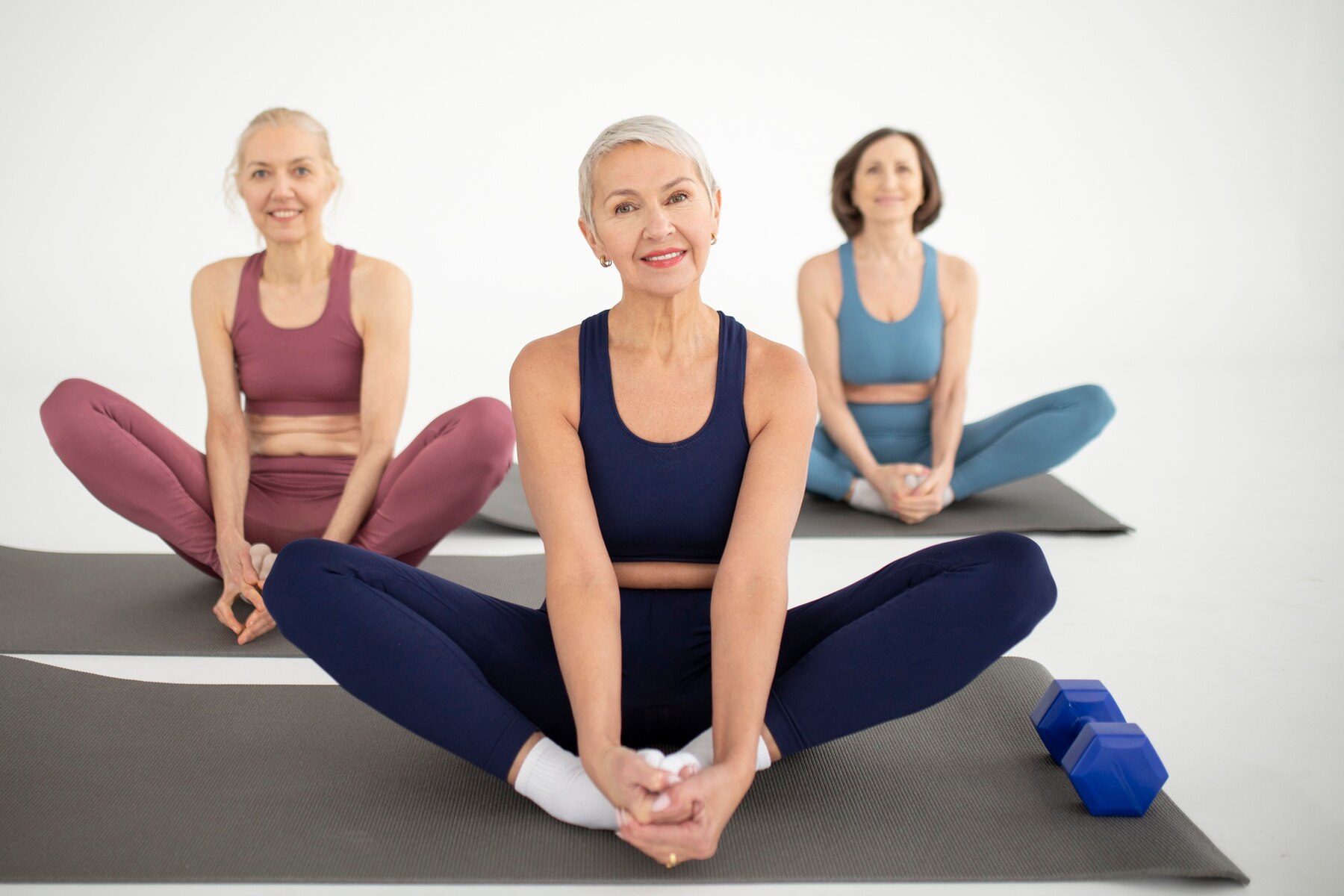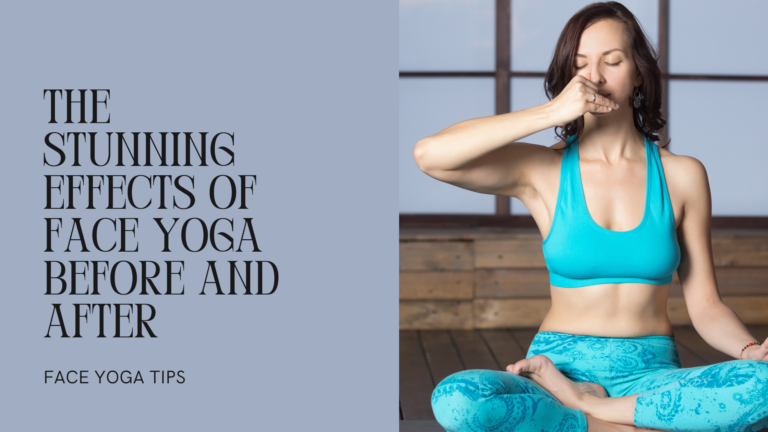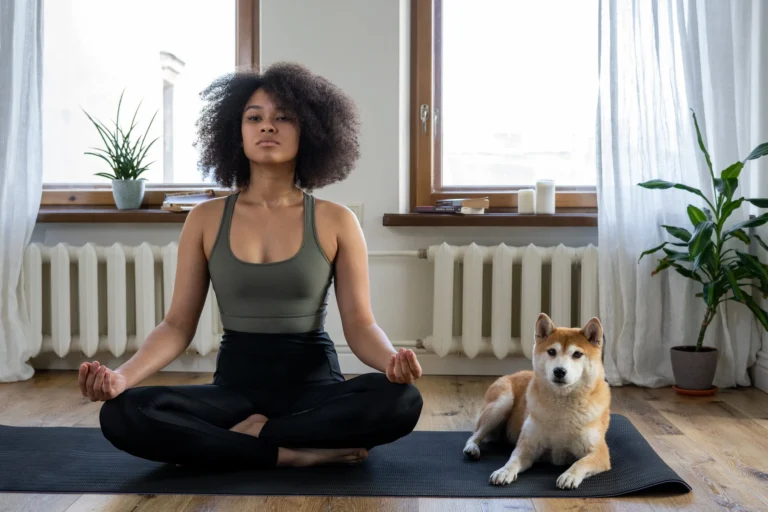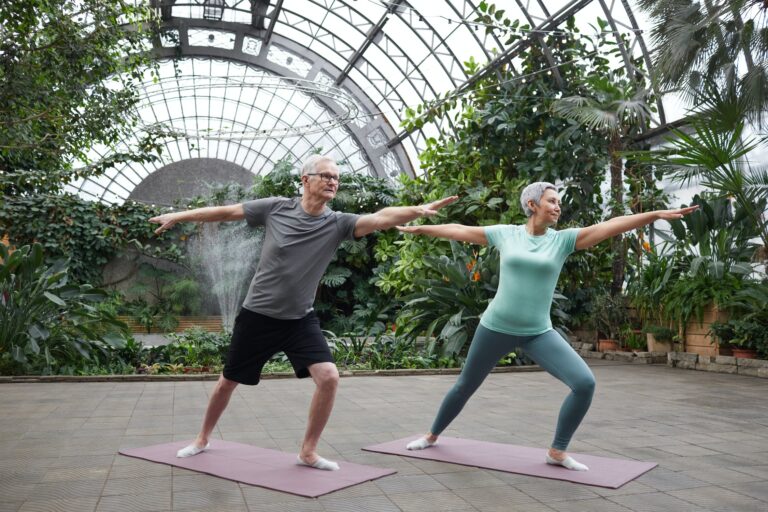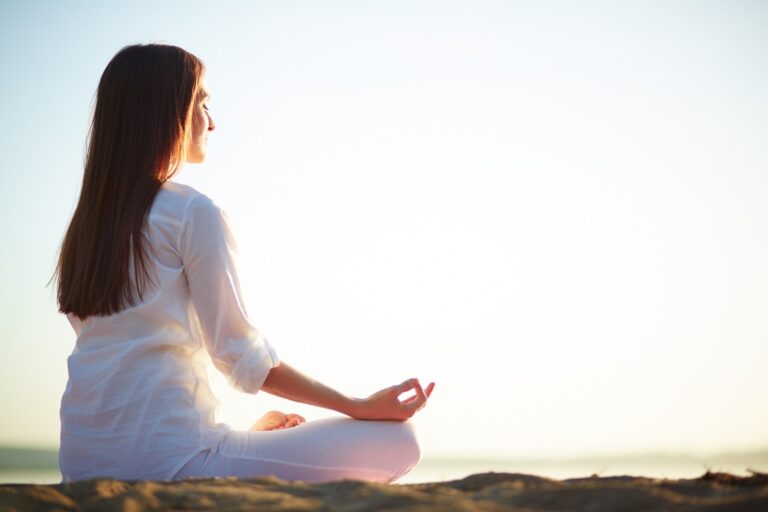10 Fun and Easy 3-Person Yoga Poses to Try Today
Are you looking for some enjoyable and uncomplicated yoga poses to try with two friends? In this blog post, we’ll explore 10 fun and easy 3-person yoga poses that you can try today. Whether you’re a beginner or have some experience with yoga, these poses are suitable for all levels. Join us as we delve into the world of group yoga and discover some exciting new poses to add to your routine.
The Benefits of 3-Person Yoga
Yoga is known for its numerous physical and mental benefits, and practicing it with a group of three can enhance the experience even further. Here are some key benefits of 3-person yoga:
Enhancing Communication and Trust

In a 3-person yoga practice, participants need to communicate effectively and trust one another to achieve harmony in their movements. This can lead to improved communication skills and a greater sense of trust and cooperation, both on and off the mat. It fosters teamwork and deepens the bond between participants.
Improving Balance and Strength
Engaging in 3-person yoga poses requires a higher level of balance and strength as participants support each other in various postures. This enhances overall physical strength and stability, as well as improving core strength and muscle coordination. It’s a fun way to challenge and strengthen the body while working together as a team.
Making Yoga More Fun
Traditional yoga can sometimes feel solitary, but 3-person yoga injects an element of playfulness and camaraderie into the practice. It adds a social aspect to yoga, making it more enjoyable and dynamic. By practicing yoga with two partners, individuals can share laughter, encouragement, and motivation, creating a more enjoyable and lighthearted atmosphere.
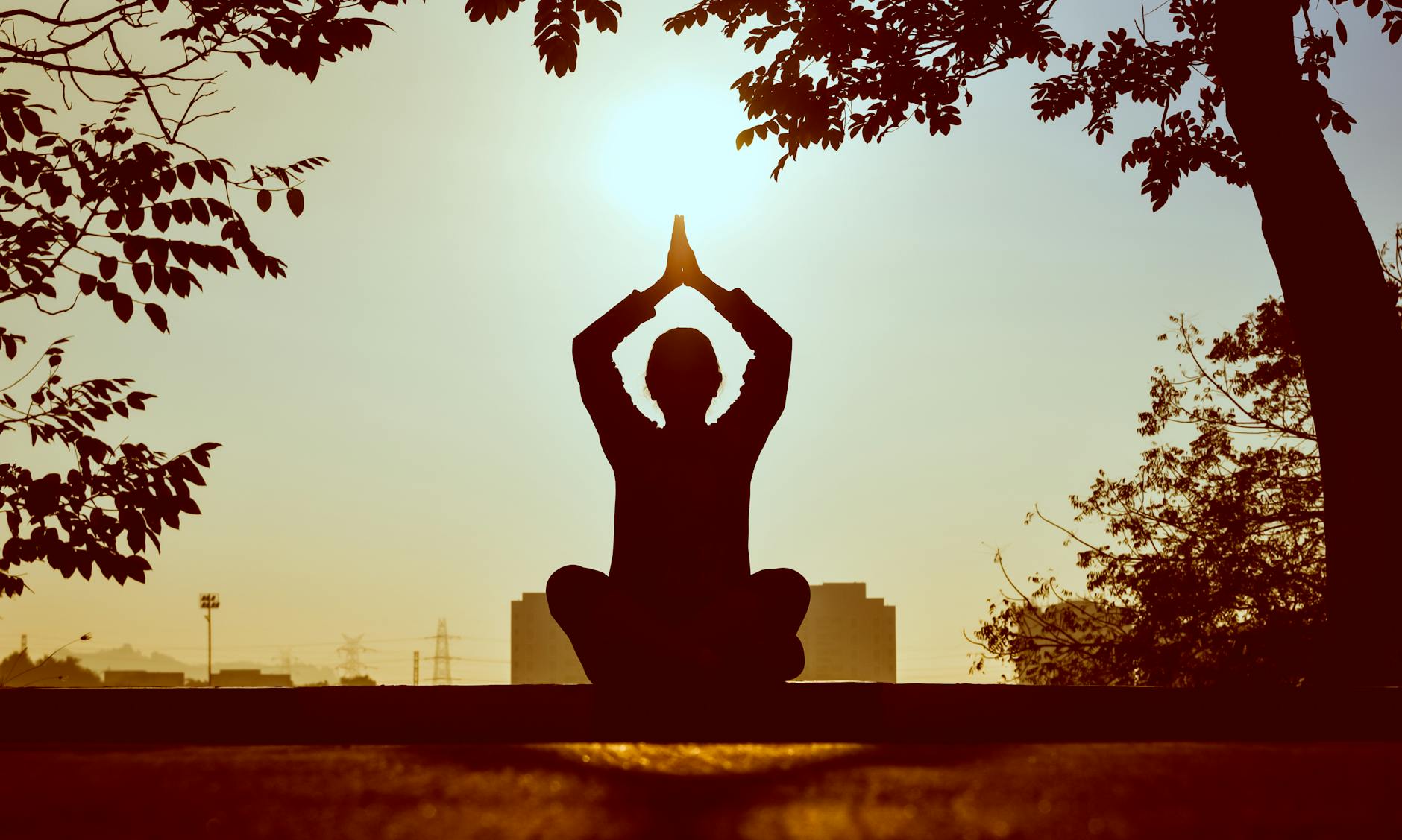
Preparing for 3-Person Yoga
Before engaging in 3-person yoga, it’s crucial to ensure the safety of all participants and prepare the body for the practice. Safety tips for group yoga involve communication, attentiveness, and awareness among all participants. Additionally, warming up properly can help prevent injuries and enhance the overall experience.
Safety Tips for Group Yoga
- Clear Communication: Establish open communication with your fellow yoga partners. Discuss any health concerns or physical limitations, and agree on signals to indicate discomfort or the need to pause during the practice.
- Respect Personal Space: Be mindful of each other’s personal space and comfort levels. Avoid pushing someone further into a pose or overstretching their limits.
- Awareness of Surroundings: Choose a spacious, clutter-free area for group yoga to prevent collisions or tripping hazards. Be attentive to the placement of props and other participants throughout the session.
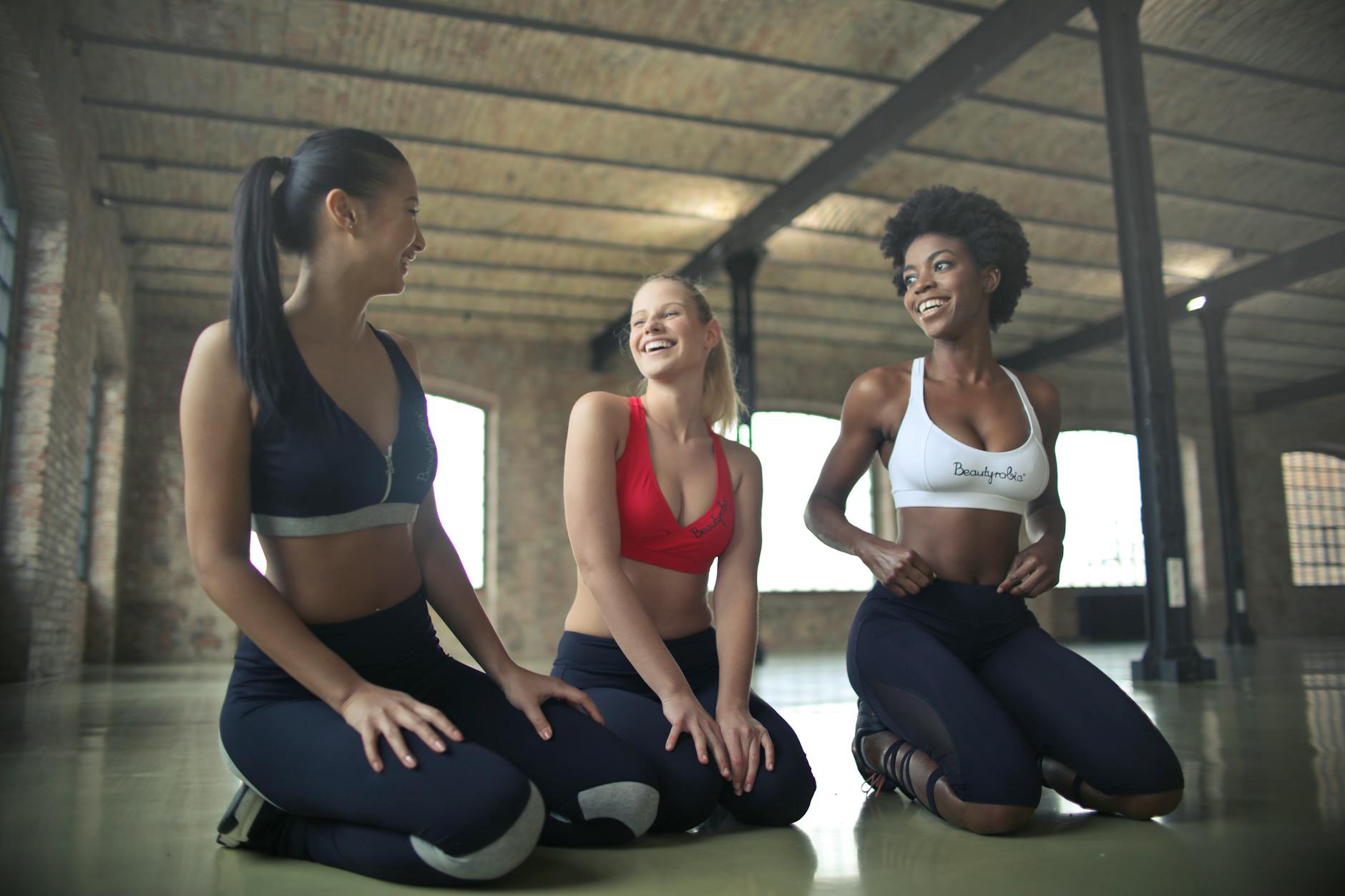
How to Warm Up Properly
- Joint Mobilization: Begin with gentle joint rotations to lubricate the joints and improve mobility. Rotate the wrists, ankles, neck, and hips in circular motions to warm them up.
- Dynamic Stretches: Engage in dynamic stretches that involve movement, such as leg swings, arm circles, and spinal twists. These movements prepare the muscles for more intense yoga poses.
- Focused Breathing: Incorporate deep breathing exercises to oxygenate the muscles and prepare the mind for the practice. Practice diaphragmatic breathing to promote relaxation and focus.
By prioritizing safety and incorporating a thorough warm-up routine, practitioners can optimize their 3-person yoga experience and minimize the risk of injury.
Double Downward Dog Pose
Practicing 3-person yoga poses can forge a profound connection and strengthen communication among practitioners. The Double Downward Dog Pose is both playful and invigorating, making it an excellent addition to your group yoga repertoire.
Pose Instructions
To begin, two individuals should come into the traditional Downward Facing Dog Pose, forming a stable foundation. The third person then carefully positions themselves between the other practitioners, ensuring that their hands are placed shoulder-width apart. While maintaining a strong core and engaged arms, the person in the middle gently rests their feet on the lower backs of the individuals forming the base. All participants should communicate and adjust their positions for comfort and stability.
Tips for Stability
- Prioritize open communication and trust among participants to ensure a safe and enjoyable experience.
- Engage the core muscles to stabilize the pose and distribute weight evenly among all participants.
- Utilize a non-slip yoga mat to minimize the risk of slipping, especially for the person in the middle.
- Ensure proper warm-up and stretching before attempting this pose to prevent any muscle strain or discomfort.

Remember, the key to mastering 3-person yoga poses like the Double Downward Dog Pose lies in patience, communication, and mutual support. Incorporating these poses into your yoga practice fosters a sense of collaboration and shared accomplishment.
Triple Warrior Pose
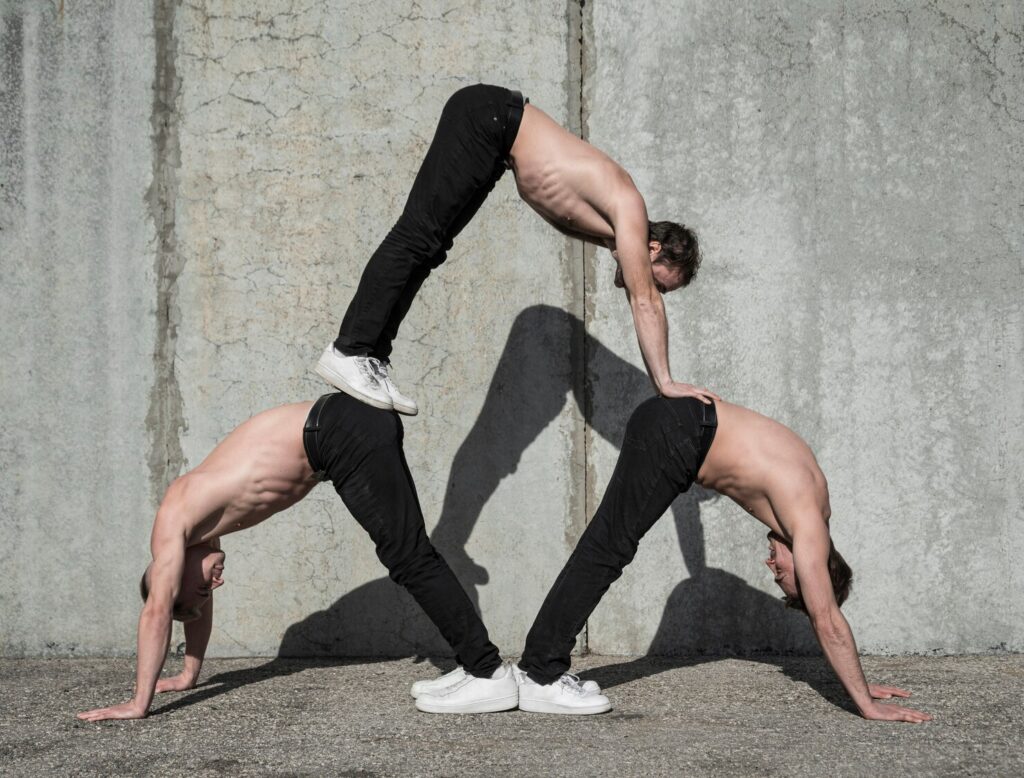
Yoga offers a multitude of poses designed for different purposes, and the triple warrior pose is both fun and challenging. This pose not only strengthens and stretches the body but also fosters balance and concentration. Here’s how you can incorporate the triple warrior pose into your yoga routine:
Pose Instructions
- Begin in a standing position at the top of your mat.
- Step your right foot back into a lunge, keeping your left knee stacked above the ankle.
- Lower your right knee to the mat and untuck your toes.
- Tilt your torso back slightly as you raise your arms overhead.
- Lift your chest and gaze upward, ensuring that your hips are squared to the front of the mat.
- Hold this pose for several breaths before repeating on the opposite side.
Modifications for Different Skill Levels
- For beginners, it’s advisable to use yoga blocks under the hands for additional support in the pose.
- Those with more experience can deepen the stretch by lowering the back knee further toward the mat.
- Advanced practitioners may incorporate a backbend or a bind to intensify the pose.
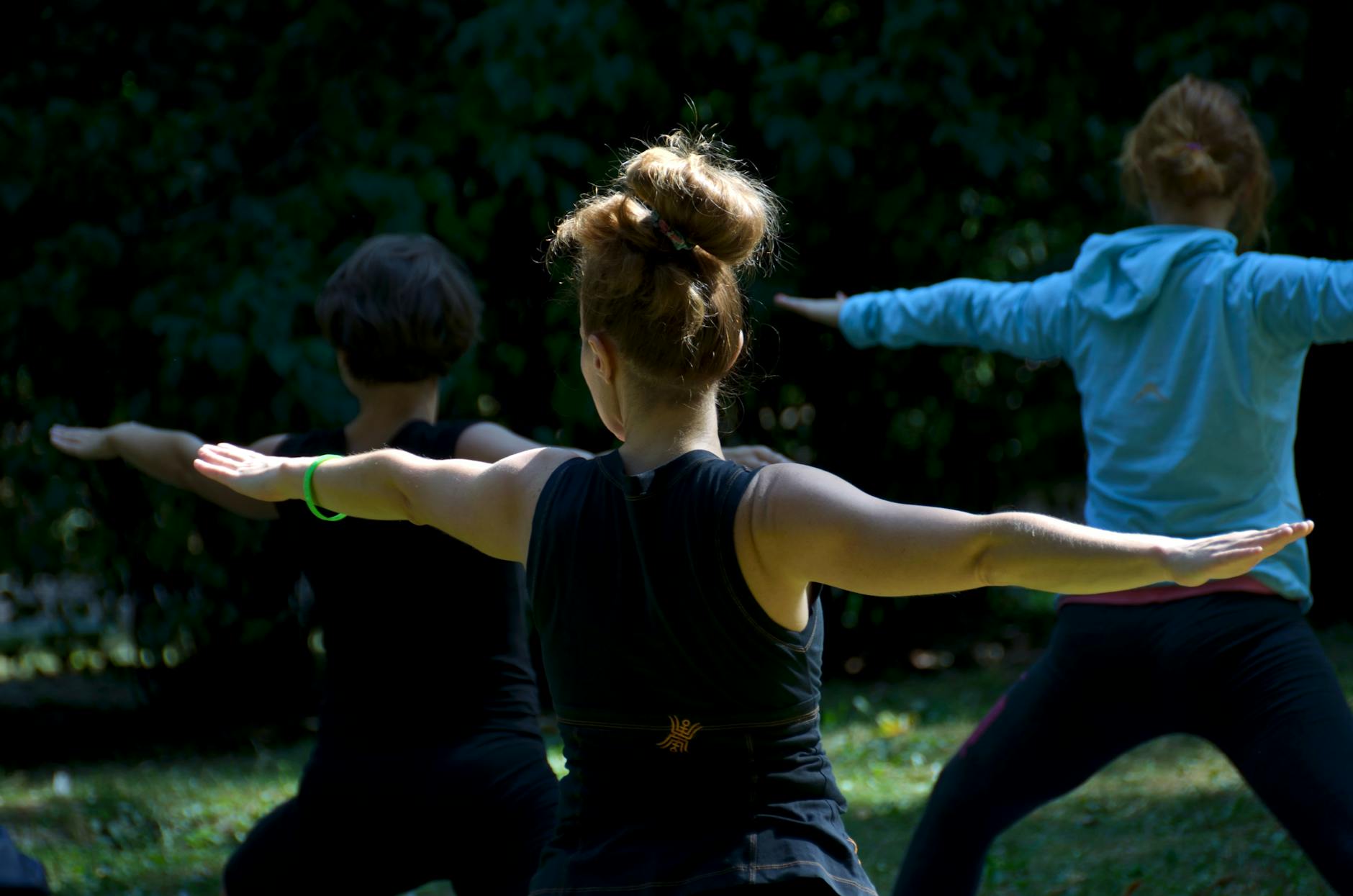
Three-Person Seated Forward Bend
Seated forward bend is an excellent yoga pose for stretching the spine and hamstrings while calming the mind. When performed in a group of three, this pose offers a unique opportunity for shared relaxation and deeper stretches. Here’s how to perform the Three-Person Seated Forward Bend along with ways to deepen the stretch:
Pose Instructions
- Initial Position: Sit on the floor with your legs extended straight in front of you. Sit tall with your spine straight and shoulders relaxed.
- Three-Person Formation: Have two people sit facing each other with their soles touching. The third person sits in front of them, facing the opposite direction and holding the hands of the other two participants.
- Bending Forward: As a group, inhale deeply and lengthen the spine. Then, exhale and gently fold forward from the hips, maintaining a straight back. All three participants should move forward as a unit, keeping the connection through their hands.
- Hold: Hold the stretch for 30-60 seconds while breathing deeply and feeling the gentle pull in the hamstrings and lower back.
How to Deepen the Stretch
To deepen the stretch in the Three-Person Seated Forward Bend:
- Gentle Support: The person in the front can lean slightly back, allowing the two partners behind to gently guide them deeper into the stretch while ensuring comfort and safety.
- Breath Synchronization: Encourage synchronized breathing among all participants to enhance the shared experience and promote relaxation.
- Gradual Progression: Slowly increase the forward bend depth as a group, ensuring that each participant communicates their comfort level.
Photo by Aline Viana Prado
The Three-Person Seated Forward Bend provides a refreshing way to connect with others while improving flexibility and promoting a sense of unity.
Circle of Trees Pose
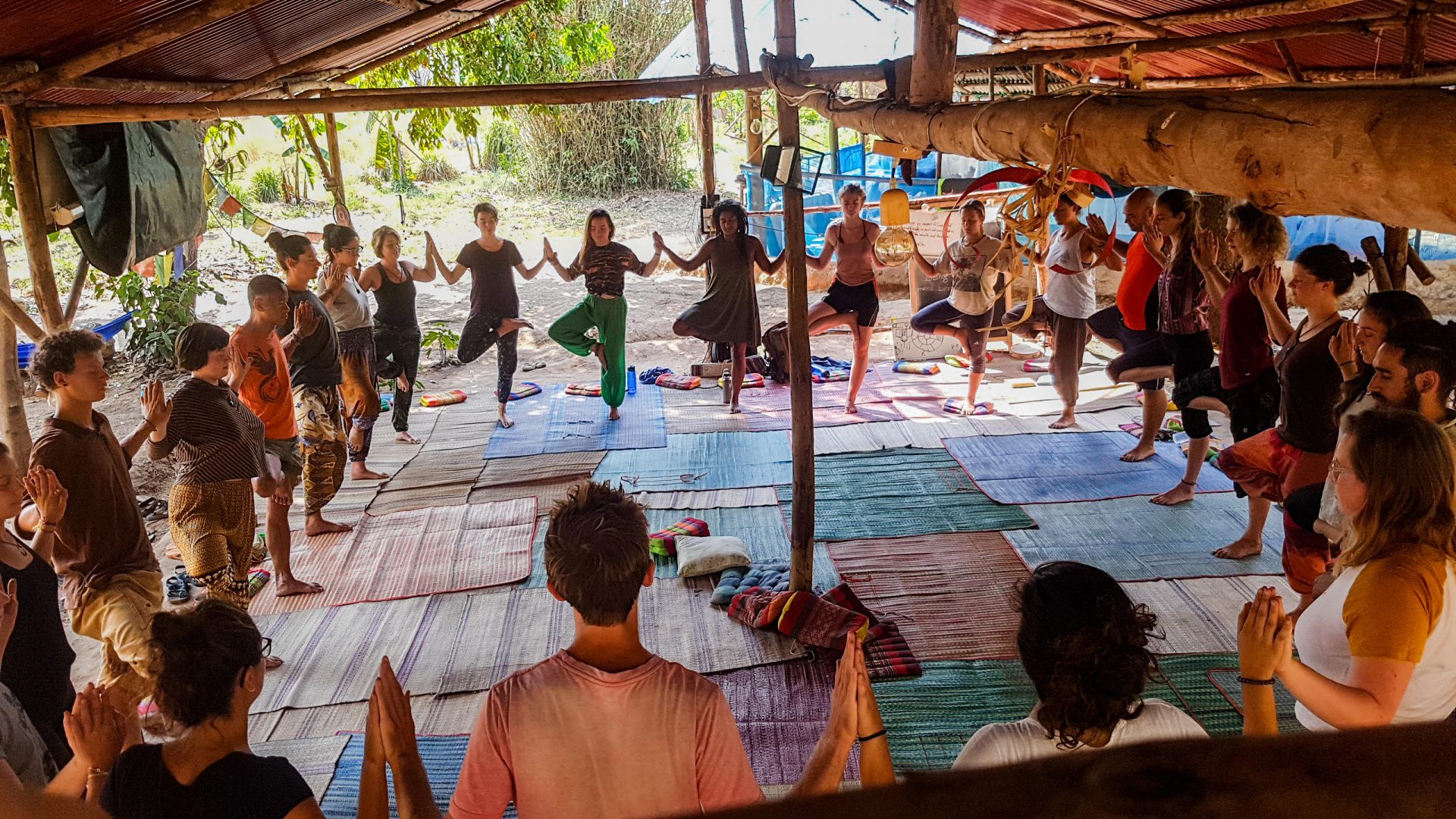
Pose Instructions
In the Circle of Trees Pose, start by standing in a circle with two partners. Begin by doing tree poses with your eyes open, standing on your right leg as your tree trunk. Then, place your left foot on your ankle, your calves, and finally on your thigh. Next, repeat the process with your eyes closed, focusing on balance and stability. Support each other by gently touching hands to steady and empower the group in holding the pose.
Benefits of the Pose
The Circle of Trees Pose focuses on joint strength and balance. This pose encourages stability, strength, and support, not only from within but also from the community. It symbolizes the power of togetherness and the immense impact of collective support in achieving a common goal. Practicing this pose fosters a sense of interconnectedness and unity within the yoga group, promoting a profound sense of community and shared achievement.
Trio Triangle Pose
The Trio Triangle Pose is a fun and engaging 3-person yoga pose that promotes balance, strength, and flexibility. When performing this pose, it’s essential to ensure proper alignment and coordination among the participants to maximize its benefits.
Pose Instructions
- Starting Position: Stand in a straight line with your yoga partners, facing the same direction.
- Triangle Formation: The person in the middle should step forward and rotate to face the opposite direction, while the other two individuals step back, creating a triangular formation.
- Arm Extension: Extend your arms to the sides, parallel to the ground. Ensure that your shoulders are relaxed and away from the ears.
- Leg Positioning: Open your legs wide, with your feet firmly grounded. Look towards the hand that is extended upwards.
Aligning Your Positions
Aligning your positions in the Trio Triangle Pose is crucial for maintaining balance and stability. Each participant should focus on the following:
- Alignment of Hips and Shoulders: Keep your hips and shoulders squared towards the front and avoid twisting excessively.
- Maintaining Equal Distance: Ensure that each participant maintains an equal distance from each other to form a symmetrical triangle.
- Steady Breathing: Focus on steady and controlled breathing to stay relaxed and centered throughout the pose.

Incorporating the Trio Triangle Pose into your yoga routine can add a dynamic and interactive element to your practice while reaping the benefits of individual and group mindfulness.
Triple Plank Pose
The Triple Plank Pose is an advanced yoga pose that requires coordination and strength. It involves three individuals forming a plank position in a synchronized manner, providing a fun and challenging way to engage in partner yoga. This pose not only fosters physical closeness but also demands teamwork and communication among the participants.
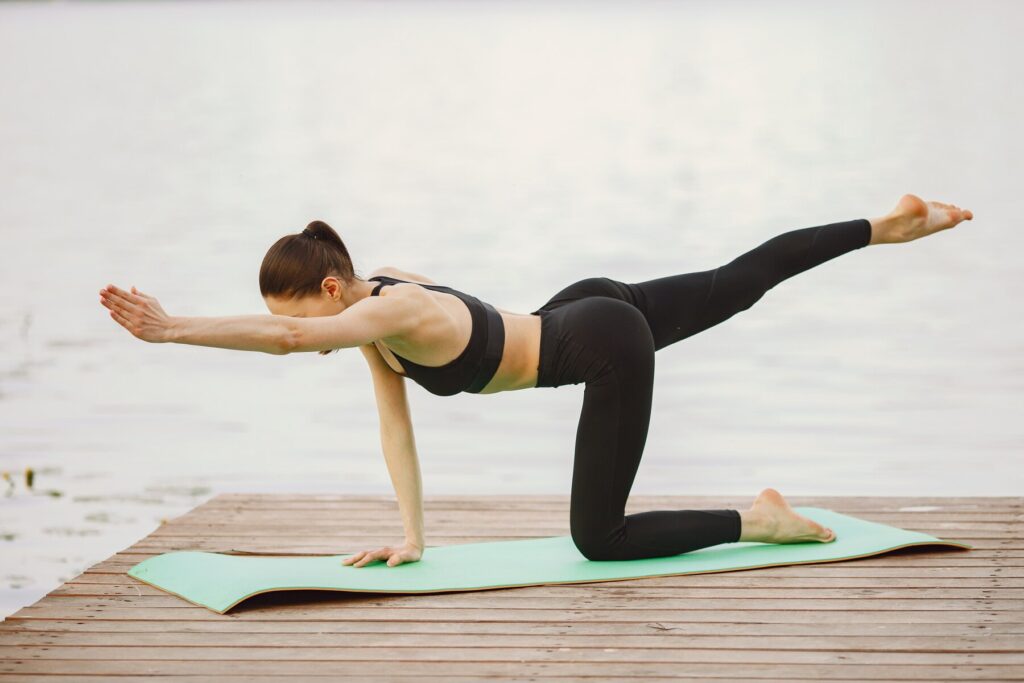
Pose Instructions
To begin the Triple Plank Pose, three participants should align themselves in a straight line, with each person assuming a traditional plank position. The individuals should position themselves so that they can maintain balance and support one another. It is essential to keep the arms straight, shoulders aligned, and core engaged to ensure stability. Participants should communicate and synchronize their movements to create a harmonious and balanced triple plank formation.
Building Core Strength
The Triple Plank Pose serves as an excellent way to cultivate core strength. Maintaining the plank position engages the abdominal muscles, lower back, and shoulders. In a group setting, this pose encourages individuals to work together to support one another’s weight, fostering a sense of unity and cooperation. Through regular practice of the Triple Plank Pose, participants can strengthen their core muscles, improve posture, and enhance overall stability.
Incorporating the Triple Plank Pose into a yoga routine can significantly enhance core strength, balance, and coordination, making it a valuable addition to partner yoga practices.
To learn more about plank exercises and their benefits, check out this resource.
In the next section, we will explore another engaging and enjoyable 3-person yoga pose.
Three-Person Chair Pose
The Three-Person Chair Pose is a challenging yet invigorating yoga pose that requires the synchronization and coordination of three individuals. This pose not only provides physical benefits but also fosters trust and communication among the participants.
Pose Instructions
- Start by having two partners stand back to back, with their feet hip-width apart.
- Each partner should bend their knees and slowly lower their hips into a seated position, creating a “chair” with their bodies.
- The third person should approach and carefully sit on the thighs of the partners, finding their balance and keeping their feet lifted off the ground.
- All participants should focus on aligning their backs and maintaining an even distribution of weight.
Keeping Balance Between Partners
To maintain balance while in the Three-Person Chair Pose, it’s essential for all participants to communicate and adjust their position as needed. Engaging the core muscles and keeping a steady gaze can also aid in stabilizing the pose. Partners can use verbal cues or subtle adjustments to ensure that weight is evenly distributed and that everyone feels supported throughout the pose.

Pose Instructions
To perform the Round Robin Twist, start in a seated position with your legs crossed. Each person should sit with their back straight and shoulders relaxed. Next, person A should twist their torso to the right and hold onto person B’s left knee, while person B reaches over and holds person C’s right knee. Person C completes the circle by reaching over to hold person A’s left knee. Take a deep breath in and, as you exhale, gently twist a little further. Hold the twist for 30 seconds and then release. Repeat the twist in the opposite direction, with each person twisting to the left and holding onto their neighbor’s knee.
Enhancing Flexibility
The Round Robin Twist is an excellent yoga pose for enhancing flexibility in the spine and hips. Through the gentle twisting motion, it helps to release tension in the back and improve mobility in the spine. This pose also stretches the muscles in the shoulders and chest, promoting better posture and reducing the risk of injury. Regular practice of the Round Robin Twist can contribute to increased flexibility and range of motion in the torso, making it easier to perform everyday movements with ease and comfort.

Shared Camel Pose
In the Shared Camel Pose, two participants mirror each other’s movements, creating a sense of unity and balance. The pose involves kneeling back-to-back with your partner, reaching for each other’s ankles, and then simultaneously leaning backward into a backbend.
Pose Instructions
- Begin by kneeling back-to-back with your partner, ensuring your knees are hips-width apart.
- Reach backward to clasp each other’s ankles firmly.
- Gradually lean back, allowing your chest to open and shoulders to relax. Encourage your partner to do the same while maintaining a strong grip on each other’s ankles.
- Hold the pose for 5-10 breaths, ensuring both partners communicate and support each other throughout the pose.
Encouraging Backbends
Backbends in yoga help open the front side of the body, counteracting the effects of sitting and slouching. They also stimulate the nervous system, improving overall alertness and energy levels. Additionally, backbends can provide a sense of vulnerability and trust, making them especially beneficial in partner yoga. Shared Camel Pose fosters a strong sense of trust and support between partners, allowing them to experience the benefits of backbending with shared encouragement.
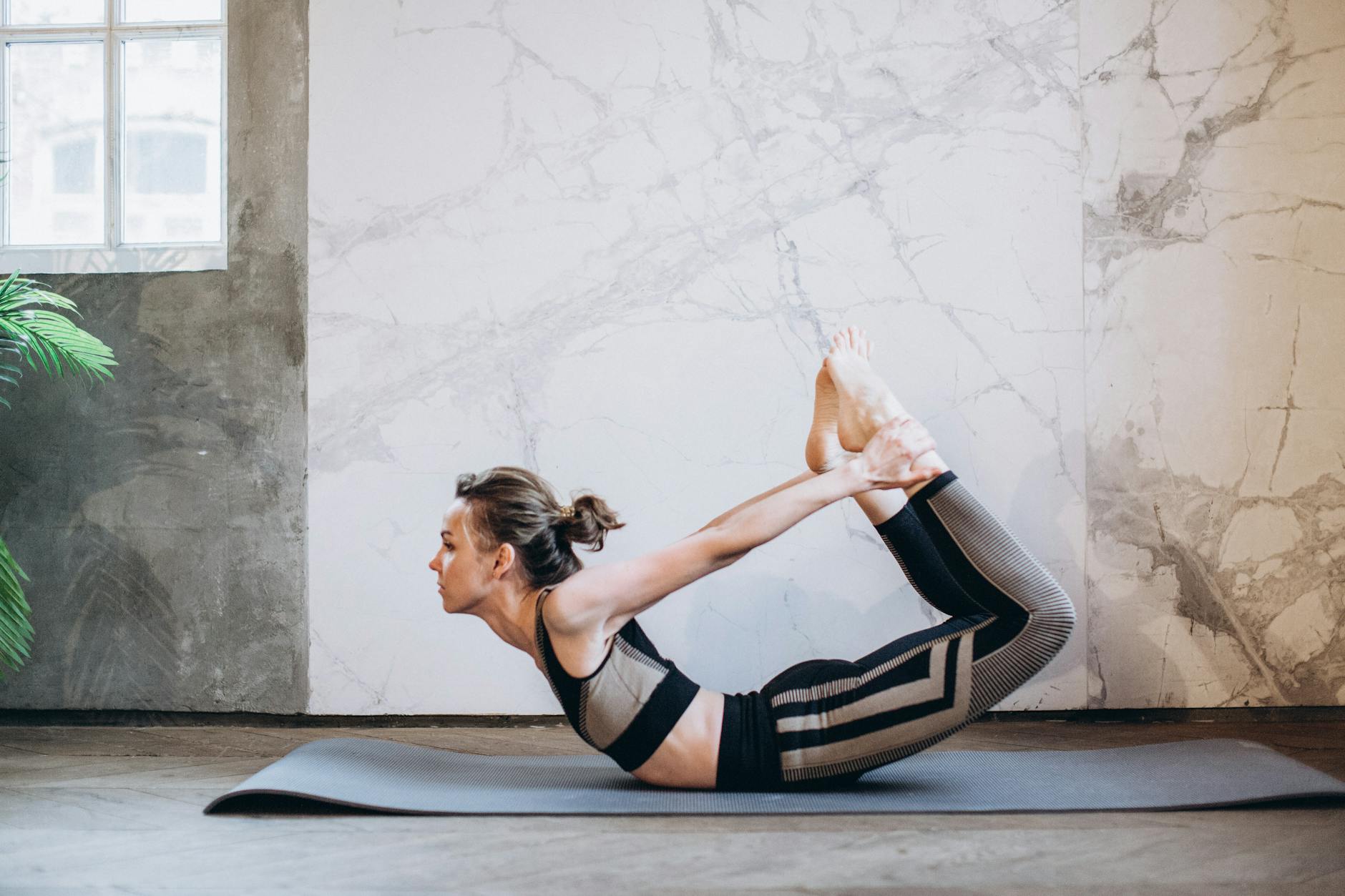
Flying Pyramid Pose
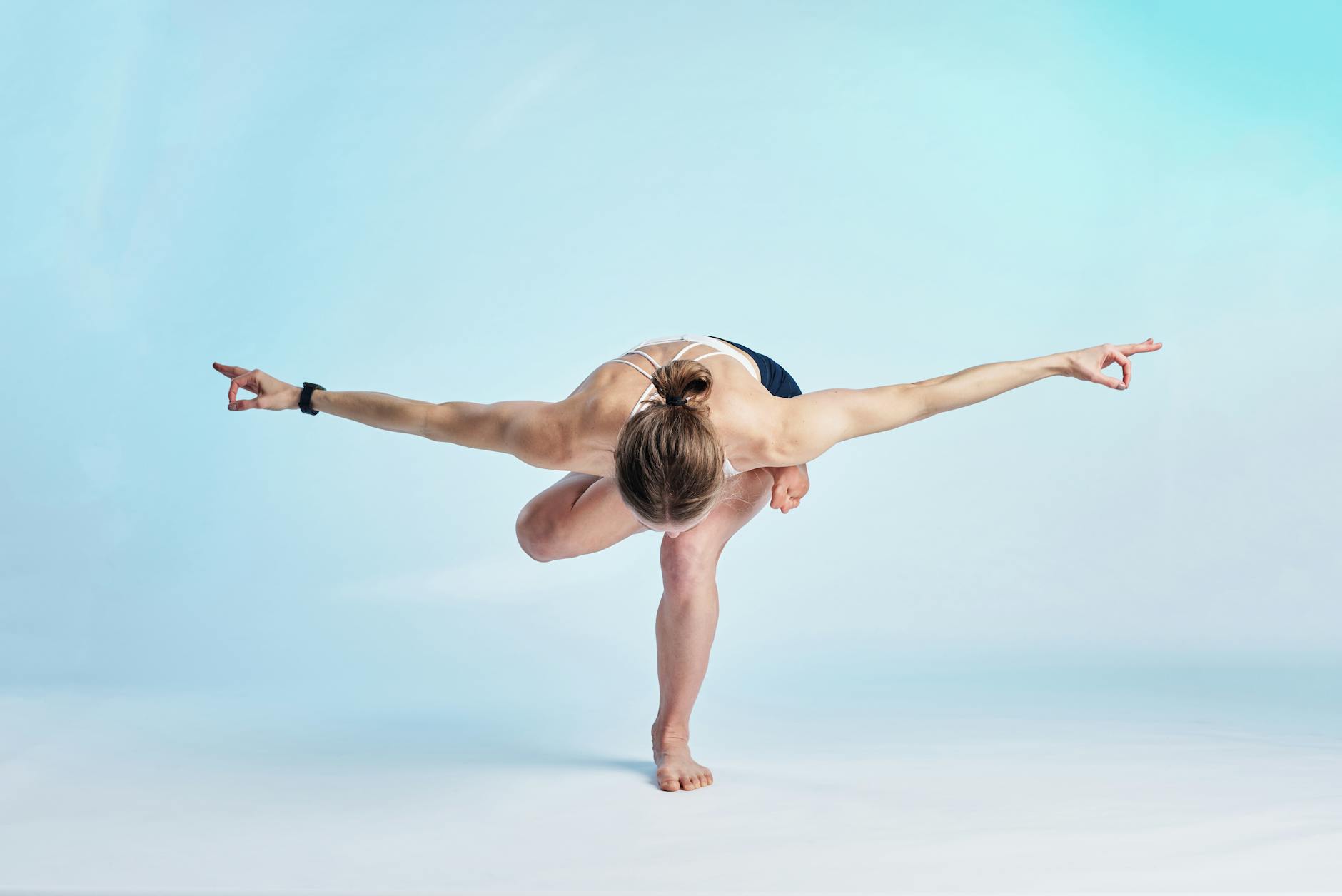
Flying Pyramid Pose is a challenging yet exhilarating 3-person yoga pose that requires balance, coordination, and trust among participants. The pose involves one person assuming the traditional Pyramid Pose, while the other two individuals provide support and stability by holding the legs of the person in the Pyramid Pose.
Pose Instructions
- Base Position: The individual assuming the Pyramid Pose should start in a standing position at the top of the mat.
- Leg Placement: Place your hands on your hips, ensuring they are squared. Step your right foot back 2 to 4 feet, aligning heel to heel with your back foot at a 30- to 45-degree angle. Keep your hips facing forward and elongate both sides of your waist by pressing down with your right big toe mound while drawing your left hip back and in towards your right heel.
- Arm Movement: Spread your arms out to the sides as you inhale. Internally rotate your arms, bend your elbows, and bring your palms together behind your back. If this is challenging, release your hands alongside your feet, on blocks, or on your shin.
- Forward Fold: Hinge at your hips as you exhale and begin to fold forward toward your front thigh. Release your forehead toward your shin while keeping your collarbones broad to maintain openness in your front body and length in your back body.
Advanced Pose Tips
- Communicate: Communication among all participants is crucial to ensure stability and safety during the pose.
- Build Trust: Establishing trust and confidence among the individuals involved is essential for successfully executing the Flying Pyramid Pose.
- Incremental Progression: Start with a simple Pyramid Pose before progressing to the Flying Pyramid Pose to ensure readiness and avoid any risk of injury.
The Flying Pyramid Pose is not only a physical challenge but also fosters a strong sense of connection and collaboration among participants, making it a fun and rewarding addition to any group yoga session.
Conclusion
Incorporating 3-person yoga poses into your practice can add a fun and dynamic element to your routine. Whether you’re looking to deepen your connection with friends or family, or simply add some excitement to your yoga practice, these poses offer a unique way to build strength, flexibility, and trust. By trying out these 10 fun and easy 3-person yoga poses, you can explore the benefits of collaborative yoga and experience the joy of synchronized movement. So grab a couple of friends and get ready to elevate your practice with these engaging and lighthearted poses.
Read More: Revealing the Hidden Power of Your Face: The Stunning Effects of Face Yoga Before and After

